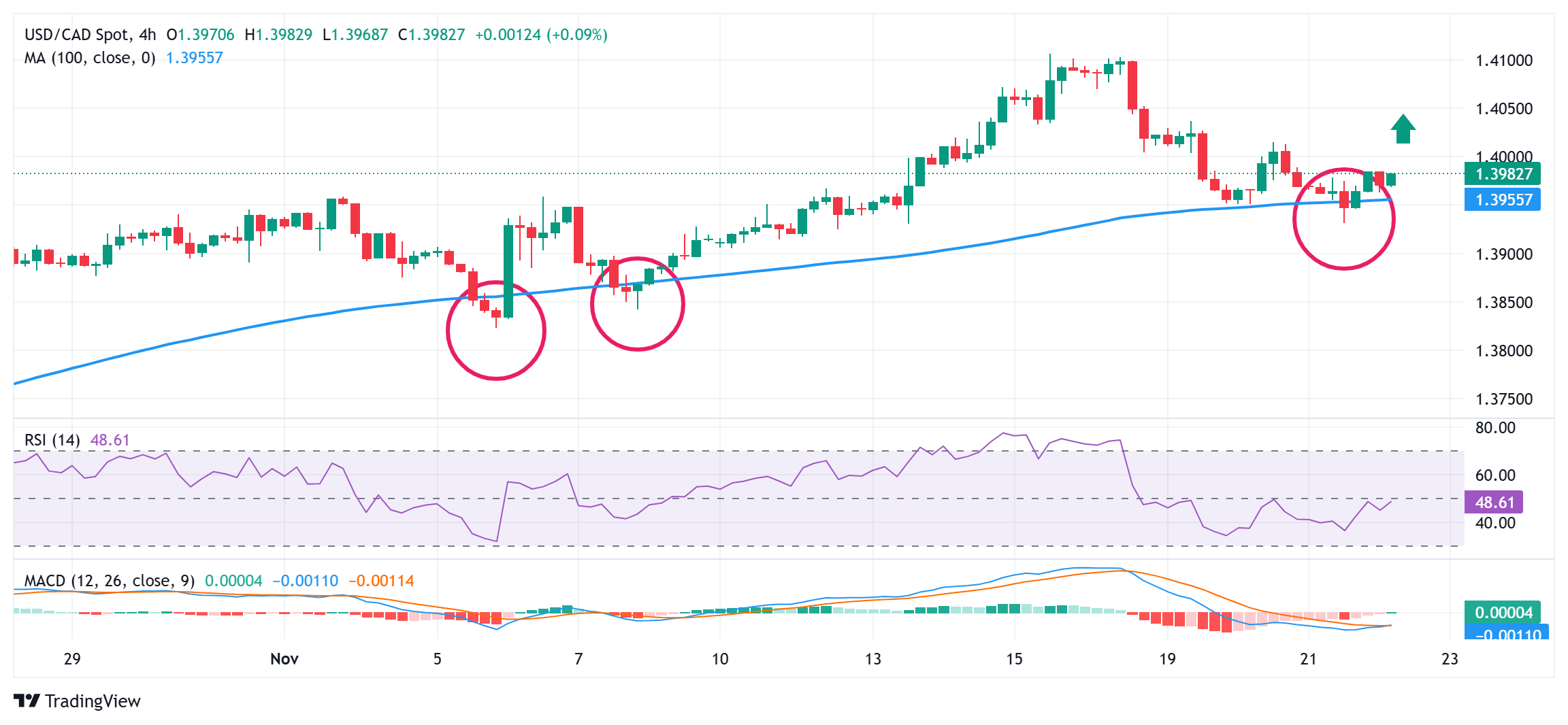USD/CAD Price Forecast: Bulls have the upper hand while above mid-1.3900s pivotal support
- USD/CAD oscillates in a narrow band and is influenced by a combination of diverging forces.
- Reduced bets for a jumbo BoC rate cut and an uptick in Crude Oil prices underpin the Loonie.
- The USD holds steady near the YTD peak and offers support amid a bullish technical setup.
The USD/CAD pair edges higher during the Asian session on Friday, albeit it lacks follow-through buying and remains below the 1.4000 psychological mark amid mixed cues.
Hotter Canadian CPI print on Tuesday forced investors to scale back their bets for a big rate cut by the Bank of Canada (BoC) in December. Apart from this, this week's goodish recovery in Crude Oil prices, from over a two-month low touched on Monday, underpins the commodity-linked Loonie and acts as a headwind for the USD/CAD pair. The downside, however, remains cushioned on the back of a strong bullish sentiment surrounding the US Dollar (USD), which continues to draw support from bets for a less dovish Federal Reserve (Fed).
From a technical perspective, the USD/CAD pair showed some resilience below the 100-period Simple Moving Average (SMA) on the 4-hour chart. The subsequent uptick, along with positive oscillators on the daily chart, suggests that the path of least resistance for spot prices is to the downside. That said, the lack of any meaningful buying interest warrants some caution before confirming that the recent pullback from the 1.4100 mark, or the highest level since May 2020 has run its course and positioning for any further appreciating move.
Meanwhile, the 100-period SMA on the 4-hour chart, currently pegged around mid-1.3900s, and the overnight swing low, near the 1.3930 area, now seems to protect the immediate downside ahead of the 1.3900 mark. A convincing break below the latter could be seen as a fresh trigger for bearish traders and accelerate the fall towards the 1.3860-1.3855 intermediate support en route to the monthly low, around the 1.3820-1.3815 region. This is closely followed by the 1.3800 round figure, which if broken decisively will set the stage for deeper losses.
On the flip side, sustained strength and acceptance above the 1.4000 psychological mark will be seen as a key trigger for bullish traders. The subsequent move-up should allow the USD/CAD pair to surpass the weekly top high, around the 1.4035 area, and aim to conquer the 1.4100 round figure. The move up could extend further towards the 1.4170 area en route to the 1.4200 mark, mid-1.4200s, the 1.4300 round figure and the 1.4340 supply zone.
USD/CAD 4-hour chart

Canadian Dollar FAQs
The key factors driving the Canadian Dollar (CAD) are the level of interest rates set by the Bank of Canada (BoC), the price of Oil, Canada’s largest export, the health of its economy, inflation and the Trade Balance, which is the difference between the value of Canada’s exports versus its imports. Other factors include market sentiment – whether investors are taking on more risky assets (risk-on) or seeking safe-havens (risk-off) – with risk-on being CAD-positive. As its largest trading partner, the health of the US economy is also a key factor influencing the Canadian Dollar.
The Bank of Canada (BoC) has a significant influence on the Canadian Dollar by setting the level of interest rates that banks can lend to one another. This influences the level of interest rates for everyone. The main goal of the BoC is to maintain inflation at 1-3% by adjusting interest rates up or down. Relatively higher interest rates tend to be positive for the CAD. The Bank of Canada can also use quantitative easing and tightening to influence credit conditions, with the former CAD-negative and the latter CAD-positive.
The price of Oil is a key factor impacting the value of the Canadian Dollar. Petroleum is Canada’s biggest export, so Oil price tends to have an immediate impact on the CAD value. Generally, if Oil price rises CAD also goes up, as aggregate demand for the currency increases. The opposite is the case if the price of Oil falls. Higher Oil prices also tend to result in a greater likelihood of a positive Trade Balance, which is also supportive of the CAD.
While inflation had always traditionally been thought of as a negative factor for a currency since it lowers the value of money, the opposite has actually been the case in modern times with the relaxation of cross-border capital controls. Higher inflation tends to lead central banks to put up interest rates which attracts more capital inflows from global investors seeking a lucrative place to keep their money. This increases demand for the local currency, which in Canada’s case is the Canadian Dollar.
Macroeconomic data releases gauge the health of the economy and can have an impact on the Canadian Dollar. Indicators such as GDP, Manufacturing and Services PMIs, employment, and consumer sentiment surveys can all influence the direction of the CAD. A strong economy is good for the Canadian Dollar. Not only does it attract more foreign investment but it may encourage the Bank of Canada to put up interest rates, leading to a stronger currency. If economic data is weak, however, the CAD is likely to fall.

